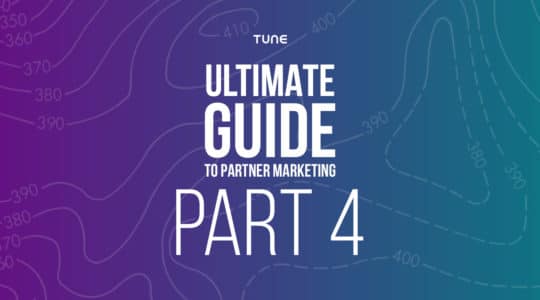The performance marketing industry is currently experiencing epic growth, as evidenced by the fact that mobile advertising revenue is expected to reach $11.4 Billion in 2013. At the same time it’s also facing a number of challenges including the rollout of Affiliate Nexus Taxes in several states over the past few years. This week, the U.S. Senate is expected to vote on the Marketplace Fairness Act, which promises to eliminate the Affiliate Nexus Tax, establish a federal sales tax, and potentially get 60,000 devastated affiliate marketers back in business.
I recently had a chance to sit down and talk with Rebecca Madigan, Executive Director of the Performance Marketing Association, about these issues, and the current state of the performance marketing industry in general. Here are a few of her thoughts:
Q: What are the biggest issues facing the performance marketing industry right now?
A: Some issues are external, such as legislation and regulation, but there are also internal issues holding the industry back. As far as regulation goes, certainly the sales tax issue is a big issue, but we believe that will be resolved this year with the passage of the Marketplace Fairness Act. Going forward I think the issue of privacy, data, and tracking will be an even bigger battle for the performance marketing industry. We are too small of an industry to have a collective voice right now to even begin to fight that battle.
One of the hot issues inside the industry is of course mobile tracking. Customers are now using multiple devices to make purchases. If someone uses their phone to start a purchase, and the affiliate doesn’t support their platform, they may wait until they get home to complete the purchase on their PC. In this scenario the affiliate could potentially not receive credit for the conversion. HasOffers has responded to this issue by developing a solution that tracks across multiple platforms.
The bigger picture with mobile, I think, is that consumers are ready to go. They’re using their devices for all sorts of things. We, as a collective ecommerce engine and advertising industry, are leaving money on the table because consumers want to use their phones to make purchases and they can’t.
Q: What are three easy ways that brands can solve that issue, now?
A: Mobile sites. Advertisers need to have a mobile site, which includes easy-to-use buttons that make it easier to pay for things and navigate the site. They need to reduce everything, and bring it down to its simplest form. Advertisers also need to invest in abbreviated privacy policies for mobile devices. Consumers want to make purchases via mobile and it’s ridiculous that advertisers are behind in making that possible.
The second thing publishers should consider is advertising for mobile devices. Going forward Google will no longer differentiate between mobile and PC traffic. This opens up an opportunity for publishers to start pitching mobile advertising tracking and thinking about mobile platforms for their own businesses and publisher sites.
The third is that whomever is doing tracking has to track across multiple platforms.
Q: Can you explain why tracking is so important across multiple devices?
A: Until advertisers have mobile sites, consumers aren’t really going to try to shop, and publishers aren’t going to try to drive traffic. This all has to happen together. Publishers aren’t going to drive traffic if it can’t be tracked. Many brands are concerned about customers comparison shopping on their mobile devices in their brick and mortar store, so they’ve been slow to adopt mobile sites.
Q: What would you say to brands to calm them down and let them know that consumers doing price comparisons are not necessarily a bad thing?
A: There are big brands who are responding and leading the charge. Macy’s and Saks Fifth Avenue, along with Best Buy and Target, are seeing this as a chance to use geotargeting to push offers to them. Drive them to your eCommerce site. Price match.
Macy’s has changed everything. It’s no longer splitting its merchandise between the store and online. It’s completely blended. They’ve put Macys.com on their doors. Clerks are walking around with tablets to help you find something online if they don’t have your size in the store. All the offline merchandise is also available online, and Macy’s can offer more online than it can in the store, as you don’t have the same space constraints. Macy’s is also storing its products differently. They’re storing merchandise and fulfilling their online orders from the store.
Q: We’ve been hearing more and more that mobile commerce is the next big thing. Can you expand on that?
A: Mobile commerce is impacting both online and offline businesses. I listened to Macy’s COO speak at a conference last year and relate how they had completely restructured their whole company around mobile commerce. Macy’s is taking the data it collects online and applying it to their brick and mortar stores.
Q: What advice would you give to a store that’s currently only operating online?
A: I think the mobile side is absolutely worth the investment. There is this gap, this pent-up demand from consumers, that want to purchase from a mobile device. If online stores are not making this possible, the consumers will go elsewhere. These companies are basically leaving money on the table.
Stores also need to realize that website optimization practices (e.g. keeping visual noise down; keeping it simple) are even more important on a mobile website. Even if they decide to not worry about advertising for the mobile consumer, they must still work to optimize their site for mobile now.
Q: Do you have any advice for advertisers or affiliates now?
A: I think the other big issue that we see is attribution. What does the funnel look like for bringing a consumer in? There’s a lot of evidence that they’re no longer going through just one affiliate before making a purchase decision. They may be introduced to an advertiser from one affiliate, but they may bounce around and look for more information. They’ll likely back out and look for a coupon.
There is technology available now that allows an advertiser to pay multiple publishers for one sale. That doesn’t make a lot of sense if you’re taking a sale and carving it up into multiple pieces. It only makes sense if you can somehow attract more sales. So, if you’re compensating people that introduce the advertiser, and paying people that close the deal, you have to see incremental growth by doing that. What attribution does do is potentially allow an advertiser to fine-tune the type of sponsors they get, or consumers they want to drive. It could allow companies to test metrics that help determine the lifetime value of a consumer. If they’re paying multiple partners to close that consumer, are they going to have a higher repeat purchase rate? Is there a segment that is going to be more likely to take advantage of an upsell?
I think this is an opportunity where technology will make it possible to increase the number of sales.
The PMA is currently fighting legislation that unfairly targets and threatens the livings of thousands of performance marketers. Please consider donating to the Performance Marketing Fairness Fund to help us continue our advocacy efforts for our industry and to help us protect the small businesses that make their living as performance marketers.
Author
Becky is the Senior Content Marketing Manager at TUNE. Before TUNE, she led a variety of marketing and communications projects at San Francisco startups. Becky received her bachelor's degree in English from Wake Forest University. After living nearly a decade in San Francisco and Seattle, she has returned to her home of Charleston, SC, where you can find her enjoying the sun and salt water with her family.




Kelly, does hasoffers really solve the problem of “If someone
uses their phone to start a purchase, and the affiliate doesn’t support
their platform, they may wait until they get home to complete the
purchase on their PC. In this scenario the affiliate could potentially
not receive credit for the conversion. HasOffers has responded to this
issue by developing a solution that tracks across multiple platforms.” How does that work since they only clicked through the link on their phone and not on their PC?